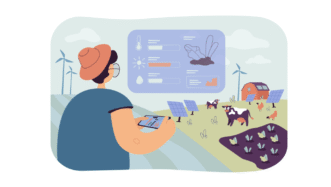LESSON OVERVIEW
We love political cartoons! They’re fun, thought-provoking and often contain witty captions. And we love cartoons by Patrick Chappatte. That’s why we decided to finally create a political cartoon lesson plan on the basis of one of his TED Talks. His speech is really awesome and the author explains the idea behind political cartooning as well as draws our attention to controversies and major questions asked in terms of political cartoons.
C1 / Advanced30 minFlipped LessonUnlimited Plan
This is a Flipped Classroom lesson plan. In a nutshell, it means that the first part of the lesson needs to be done by students at home. Learn more about flipped classroom and how we implement it in these lesson plans in our post.
PRE-CLASS ACTIVITIES
The activities from this political cartoon lesson plan that students have to do at home involve both vocabulary and grammar points. First, students have to complete a few sentences with words given. These sentences come from the video and introduce students to some vocab that might be useful to know before watching the speech. To check their answers, students must watch the video. Next, they move to a grammar point. It touches on what-clauses (or pseudo-cleft sentences). Students need to study a short table with examples of the use of these clauses to emphasize the ideas we want to express. After examining the table, students should do one exercise, that is rewrite sentences using what-clauses. Why do we introduce them here? Because we want students to get familiar with them, and then use them when discussing some cartoons in the classroom.
IN-CLASS ACTIVITIES
As it is a political cartoon lesson plan, the in-class activities start with an exercise on vocabulary. It is a word formation task which also check students’ knowledge of vocabulary connected with the topic (and in most cases coming from the video they watched at home). Students get a table and they need to complete it with correct parts of speech. The sets of words include: cartoonist, caricaturist, criticize, propagandize, provocative, censorship, etc. Next, there is an extensive discussion about political cartooning, satire and freedom of speech. Finally, the last task is the most advanced one as students need to use their critical thinking skills to analyze, understand and discuss some political cartoons. While we curated a list of political cartoons that can be used in the lesson (see Teacher’s Version), we encourage you to create your own set that will best fit your students. Browse such websites as:
- https://www.chappatte.com/en/images/
- https://www.gocomics.com/comics/political
- https://www.facebook.com/NewYorkerCartoons/
We’ve chosen (and provided links) to some cartoons that we like and think can be nice to analyze (see Teacher’s Version). To help your students approach the task, we provided questions that they should answer when describing cartoons as well as some useful expressions to help them formulate their opinions and ideas.
WORKSHEETS
Subscribe to unlock these and many other Standalone lesson lesson plans with the Unlimited plan
Subscribe














Great lesson, a few problems while I was in class, the TV and the SV don’t match the blanks (the tv doesn’t have red in the blanks that the students have). Also is this correct “I am interested in colours used in this cartoon.
What interests me is colours used in this cartoon.” Or should it be, What interests me ARE colours used…
Thanks again for all of your hard work.
David, I’m not sure what you’re referring to in terms of the blanks (check the newest version available – we fixed some small typos). Now the other thing is actually correct as the subject here is “what interests me” and therefore the verb “is” agrees with the subject. Having said that, verbs can agree with plural complement in cleft sentences so you may also say “what interests me are colours..”. See: https://www.thoughtco.com/what-clause-1692605
Hello! Thank you for the topic idea, I like the grammar sections as well.
In question 1, slight error, in the box for words given, it says ”rules” but it should say ”ruled”.
Thanks again!
Thanks Clara! I’ve noticed it myself when doing this lesson 🙂 Fixed already!
Good spot! I didn’t notice this one. Maybe it should be ”what interests me are the colours used in this cartoon.”?
Clara, see my reply to David’s comment above for explanation.